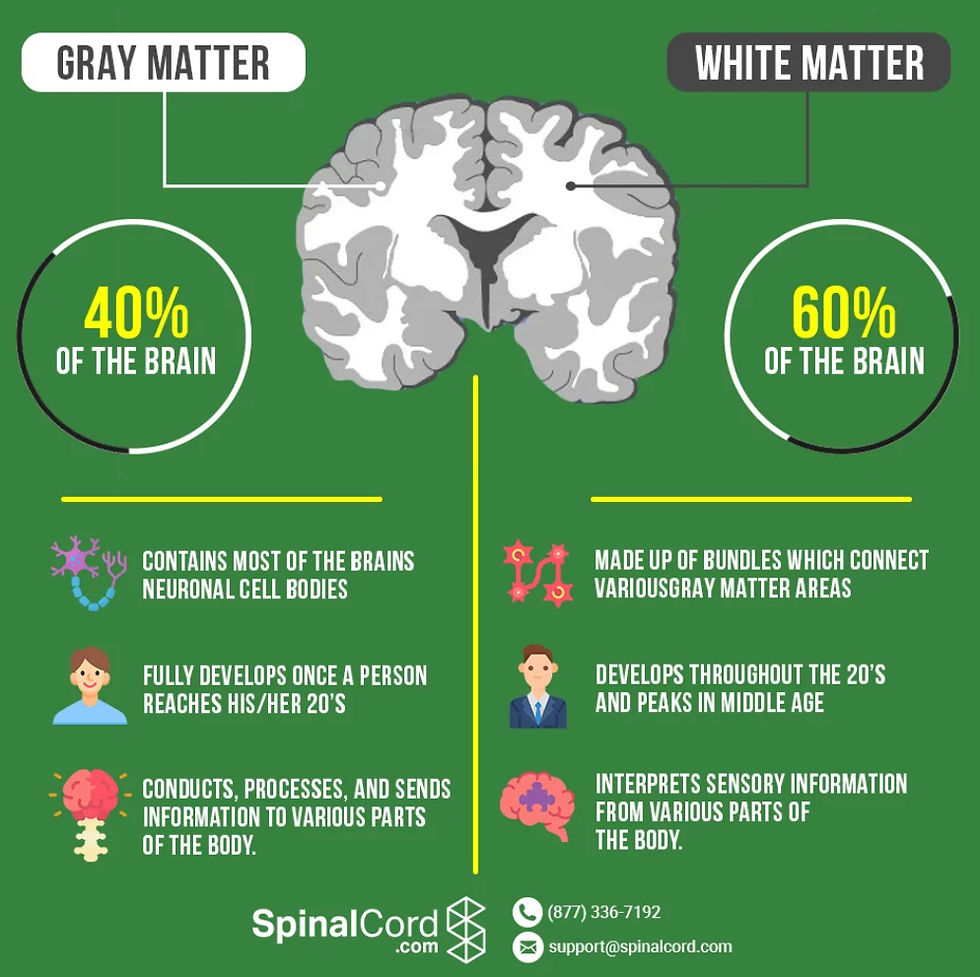Gray Matter, White Matter & Neuroplasticity: How to Strengthen Your Brain’s Neural Pathways
- Sasha Tanoushka BCH IACT

- Feb 8
- 2 min read
The brain is an intricate network of gray matter and white matter, working together to control everything from sensory perception to motor function. But did you know that the health of these neural structures can determine how well you think, move, and process the world around you?
By understanding how gray and white matter function—and how to stimulate neuroplasticity—we can actively optimize brain health, enhance cognitive function, and even slow neurological decline.
What’s the Difference Between Gray Matter & White Matter?

Gray matter, despite its name, has a pinkish-gray color due to its dense concentration of neural cell bodies, dendrites, and synapses. It’s responsible for processing information, making decisions, and interpreting sensory input. It’s found in key brain regions like:
✅ The cerebrum (higher thinking, memory, and emotion)
✅ The cerebellum (coordination and motor control)
✅ The brainstem (autonomic functions like breathing and heart rate)
Gray matter also extends into the spinal cord, forming a butterfly-shaped structure that plays a vital role in movement and sensation:
- The posterior (dorsal) gray horn helps your brain process sensory signals like touch, temperature, and pain.
- The anterior (ventral) gray horn controls motor signals, sending instructions to your muscles. Damage here can lead to **muscle weakness, tingling, or even paralysis
White matter, on the other hand, consists of bundles of axons covered in myelin, a fatty substance that speeds up communication between brain regions. This connective tissue acts like the highways of the nervous system, conducting and processing nerve signals. Damage to white matter can disrupt motor function, sensory perception, and reflexes.
Why Is White Matter Health Important?
Increased white matter can be beneficial—strengthening neural connections for better cognitive function, faster thinking, and improved movement. But in some cases, white matter hyperintensities (abnormalities often seen in aging or neurodegenerative conditions) can indicate a decline in brain health, increasing the risk of stroke, dementia, or cognitive impairment.
So, how do we protect and enhance both white and gray matter for a healthier brain?
Boosting Neuroplasticity: Strengthening Your Brain’s Pathways
Your brain isn’t a static organ—it’s constantly evolving through neuroplasticity, its ability to rewire and adapt. By engaging in specific brain-training practices, you can strengthen gray matter, reinforce white matter connections, and optimize brain function.
Here are powerful neuro modalities to enhance brain plasticity:
🧠 Hypnosis & Meditation – Reduce stress, regulate emotions, and enhance cognitive flexibility.
💭 Visualization & Mental Rehearsal – Strengthen neural pathways for better memory, learning, and performance.
🚶♂️ Physical Activity – Stimulates white matter myelination, enhancing brain connectivity and reducing neurodegenerative risks.
🎶 Music & Rhythmic Training – Improves coordination, boosts cognitive function, and strengthens sensory-motor connections.
🔄 Novel Learning & Adaptation – Engaging in new experiences (learning an instrument, practicing a new language) helps expand gray matter density and promotes neuroplasticity.
Your Brain Is Meant to Grow
Understanding the delicate balance between gray and white matter helps us take charge of our brain health. Whether you want to sharpen your thinking, enhance memory, or protect against cognitive decline, activating neuroplasticity is the key to long-term mental agility and well-being
What’s your favorite way to challenge your brain and keep it strong?




Comments